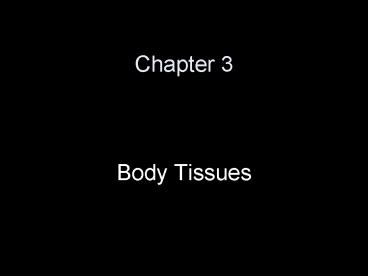Body Tissues - PowerPoint PPT Presentation
1 / 23
Title:
Body Tissues
Description:
... breasts Reticular connective tissue Forms stroma (bed) in lymph nodes, spleen, bone marrow Blood (vascular tissue) Blood cells surrounded by nonliving, ... – PowerPoint PPT presentation
Number of Views:220
Avg rating:3.0/5.0
Title: Body Tissues
1
Chapter 3
- Body Tissues
2
- Epithelial (epithelium) Tissue
- Epithet laid on, covering
- Lining, covering, glandular
- Functions protection, absorption, filtration,
secretion - Characteristics
- Fit closely forming continuous sheets
- Apical surface 1 free surface exposed to
bodys exterior/interior - Lower surface rests on basement membrane
secreted by the cells - Avascular no blood supply of their own
- Depend on diffusion
- Regenerate
3
- 2 names based on of layers and cell shape
- Simple epithelia one layer
- Simple squamous (fish scale)
- Allow rapid diffusion air sacs, capillaries
- Produce serous membranes (serosae) line ventral
body cavity - Simple cuboidal (cube shaped)
- Glands and their ducts salivary, pancreas
- Kidney tubule walls
- Ovary surface
4
- Simple columnar (columns)
- Goblet cells produce lubricating mucus
- Line digestive tract
- Mucus membranes (mucosae) line body cavities
that open to exterior - Pseudostratified columnar
- Different heights
- Line respiratory tract
- May have cilia
5
- Stratified epithelia 2 or more cell layers
- Stratified squamous
- Most common
- Esophagus, mouth, outer skin (friction areas)
- Free edge squamous
- Basement membrane cuboidal or columnar
6
- Stratified cuboidal Stratified columnar
- Rare
- Ducts of large glands
- Transitional
- Modified stratified squamous allow much
stretching - Urinary bladder, ureters, part of urethra
7
- Glandular epithelium
- Glands 1 or more cells that make and secrete a
particular product - Endocrine glands
- Ductless glands
- Secretions diffuse directly into blood vessels
- Ex. thyroid, adrenals,
- pituitary
- Exocrine glands
- Have ducts
- Secretions empty directly on epithelial surface
- Ex. sweat, oil, liver, pancreas
8
- Connective tissue
- Most abundant
- Protection, support, binding
- Characteristics
- Variation in blood supply lower supply slower
healing
9
- Extracellular matrix nonliving substance bound
outside cell produced by connective tissue - 2 main elements
- 1.Ground substance
- Water, adhesion proteins, polysaccharides
- Fluid, gel-like, rock hard
- Adhesion proteins glue attaches connective
tissue to matrix fibers - Absorbs large amounts of water reservoir
- 2. Fibers
- Collagen white high tensile strength
- Elastic yellow stretch/recoil
- Reticular internal skeleton of soft organs
(spleen)
10
- Functions forms soft packing tissue, bears
weight, w/stand stretching/abrasions - Ex. Fat tissue many cells soft matrix
- Ex. Bone/cartilage few cells hard matrix
- Types based on differences in fiber type and
fiber - Bone osseous tissue
- Bone cells in cavities (lacunae)
- Surrounded by hard matrix w/ calcium salts and
lots of collagen - Support, protection
11
- Cartilage
- Hyaline cartilage
- Most widespread
- Abundant collagen, rubbery matrix
- Ex. Surrounds larynx, attaches ribs to
breastbone, covers ends of bones - Prenatal skeleton replaced by bone by birth
- Fibrocartilage cushioning disks of spinal cord
- Elastic cartilage elasticity ear
12
- Dense connective tissue (dense fibrous tissue)
- Collagen fibers
- Tendons attach muscles to bone
- Ligaments attach bone to bone
- Dermis lower layer of skin
13
- Loose connective tissue
- More cells and fewer fibers
- Areolar tissue
- Most widely distributed connective tissue
- Cushions/protects body organs
- Universal packing tissue
- Glues internal organs together
- Lamina propria under
- all mucous membranes
- Water/salt reservoir
- Edema swelling caused by collecting excess
fluid - Phagocytes
14
- Adipose tissue (fat)
- Signet ring cells contain large oil droplet
that pushes nucleus to side - Subcutaneous tissue under skin
- Insulates/protects
- Fat deposits hips, breasts
15
- Reticular connective tissue
- Forms stroma (bed) in lymph nodes, spleen, bone
marrow
16
- Blood (vascular tissue)
- Blood cells surrounded by nonliving, fluid matrix
(plasma) - Fibers are only seen during clotting
17
- Muscle tissue
- Contract and shorten
- Skeletal muscle
- Attached to skeleton
- Voluntary control
- Pulls on bone or
- skin movement
- Multinucleate
- Striations
- Cells aka muscle fibers because their elongated
18
- Cardiac muscle
- Only in heart
- Involuntary control
- Uninucleate
- Striations
- Intercalated disks where branching cells fit
together contain gap junctions
19
- Smooth muscle (visceral muscle)
- No striations
- Spindle shaped
- Found in walls of hollow organs stomach, blood
vessels - Contraction cavity smaller
- Relaxation cavity larger
- Ex. Peristalsis small intestines
20
- Nerve tissue
- Neurons nerve cells
- 2 characteristics irritability and conductivity
- Cytoplasm drawn into long processes
21
Tissue Repair
- Inflammation nonspecific attempts to prevent
further injury - Immune responses attacks specific invaders
- Repair (healing)
- Regeneration replacement of cells
- Fibrosis repair by fibrous connective tissue
scar tissue - Type of repair determined by
- Type of tissue damaged
- Severity of damage
22
- Process
- Capillaries become permeable
- Allow clotting to occur
- Stop blood loss, holds wound edges, walls of
injured area - Granulation tissue forms
- Composed largely of new capillaries
- Contain phagocytes dispose of clot and scar
tissue - Surface epithelium regenerates
- Grows under scab
- Scar may be visible depends on severity of
wound - Epithelial and connective tissues regenerate
well. - Muscle and nervous may not regenerate at all.
23
Tissue Development
- Neoplasm loss of control over cell division
- May be benign or malignant
- Hyperplasia cells multiply due to an irritant
or condition - Ex. Breast enlargement due to pregnancy
- Atrophy decrease in size not used or loses
nerve supply































